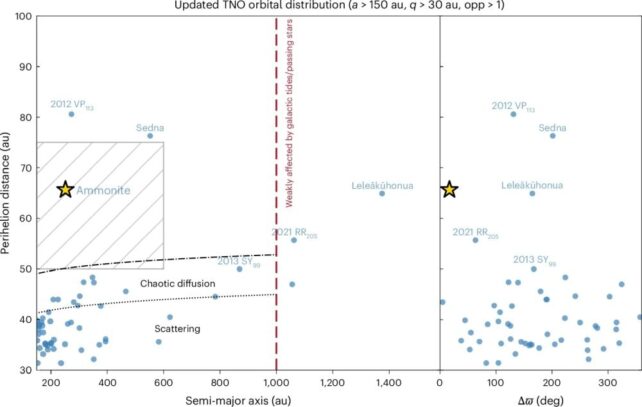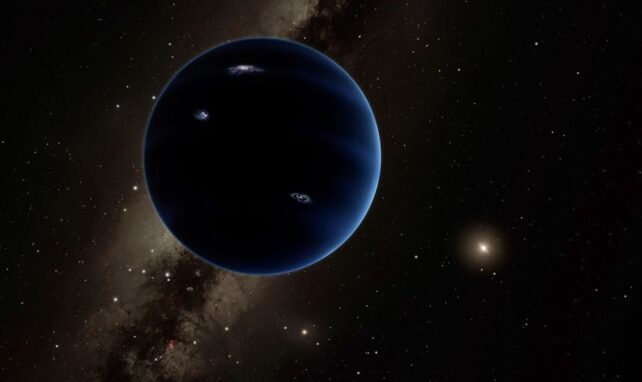Despite the powerful telescopes that modern astronomers have to work with, the distant reaches of the Solar System are still mysterious. Not much sunlight pierces these regions, and there are strong hints that undiscovered objects lurk there.
The objects that astronomers have discovered in these dim reaches are primordial, and their orbits suggest the presence of more undiscovered objects. Piecing it all together is a challenge.
While some objects announce themselves with fiery explosions or streaks of light across the sky, distant Solar System objects don’t attract much attention. They reveal themselves in tiny hints; a nearly imperceptible tug on another object, a nearly-invisible and short-lived glimmer of light. Yet these objects have something important to tell us about how our Solar System formed and evolved.
Astronomers have detected hints of a ninth planet in the Solar System’s distant reaches. This hypothetical and elusive Planet Nine is held up to explain the puzzling orbital groupings of a family of distant objects called Trans-Neptunian Objects (TNO).
Related: ‘Strongest Statistical Evidence Yet’ For Planet Nine Has Been Found, Scientist Says
Astronomers working with Japan’s Subaru Telescope in Hawaii found evidence of a new distant object in the Solar System. It’s a Trans-Neptunian Object, meaning it orbits the Sun at a greater average distance than Neptune, the outermost planet.
But it’s also a member of an important and puzzling sub-class of objects: Sednoids. It’s name is 2023 KQ14, but its nickname is Ammonite, after the fossilized cephalopod.
Sednoids follow more extreme orbits than TNOs. Their orbits are extremely elongated, with high eccentricity, distant perihelia, and large semi-major axes. They’re named after the dwarf planet Sedna, and the new discovery is only the fourth Sednoid ever detected.
A new paper in Nature Astronomy presented the discovery. It’s titled “Discovery and dynamics of a Sedna-like object with a perihelion of 66 au.” The lead author is Ying-Tung Chen from the Academia Sinica Institute of Astronomy and Astrophysics in Taipei, Taiwan.
“Understanding the orbital evolution and physical properties of these unique, distant objects is crucial for comprehending the full history of the Solar System.” – Dr. Fumi Yoshida, co-author.
Ammonite was first detected with the Subaru Telescope during observation efforts in March, May, and August 2023. Those observations alone weren’t sufficient to confirm the dim object’s existence, and follow-up observations in July 2024 with the Canada-France-Hawaii Telescope, as well as a search through archived data from other observatories, provided confirmation. Overall, the researchers tracked Ammonite’s orbit for 19 years.
Ammonite was found as part of the FOSSIL (Formation of the Outer Solar System: An Icy Legacy) observing program. It uses the Subaru Telescope’s powerful HyperSuprimeCam to measure the populations and sub-populations of the objects that populate the outer Solar System.
The FOSSIL team used computer numerical simulations to determine that Ammonite has followed a stable orbit for at least 4.5 billion years, dating all the way back to the Solar System’s earliest times. Ammonite’s orbit is currently different from the other Sednoids, but the simulations show that their orbits were all similar about 4.2 billion years ago.
There’s an odd gap in distant Solar System objects when it comes to their perihelion distances and Ammonite sits in that gap.
“The orbit of Ammonite does not align with those of the other Sedna-like objects and fills the previously unexplained ‘q-gap’ in the observed distribution of distant Solar System objects,” the authors explain in their paper.

Dr. Yukun Huang of the NAOJ is a co-author of the paper who conducted simulations of Ammonite’s orbit. “The fact that 2023 KQ14’s current orbit does not align with those of the other three sednoids lowers the likelihood of the Planet Nine hypothesis,” Huang said in a press release.
“It is possible that a planet once existed in the Solar System but was later ejected, causing the unusual orbits we see today.”
Neptune is the only known massive object near the outer Solar System that could have shaped the orbits of the TNOs and Sednoids. But according to study co-author Dr. Fumi Yoshida, Ammonite is beyond its reach.
“2023 KQ14 was found in a region far away where Neptune’s gravity has little influence. The presence of objects with elongated orbits and large perihelion distances in this area implies that something extraordinary occurred during the ancient era when 2023 KQ14 formed,” Yoshida said.
“Understanding the orbital evolution and physical properties of these unique, distant objects is crucial for comprehending the full history of the Solar System. At present, the Subaru Telescope is among the few telescopes on Earth capable of making such discoveries.
“I would be happy if the FOSSIL team could make many more discoveries like this one and help draw a complete picture of the history of the Solar System.”
 allowfullscreen=”allowfullscreen” frameborder=”0″>
allowfullscreen=”allowfullscreen” frameborder=”0″>Ammonite’s orbit is now different from the other Sednoids, and that fact needs an explanation. It’s evidence that there’s more complexity and diversity among distant Solar System objects.
Astronomers have long wondered if our Solar System hosts a ‘Planet Nine‘ that has shepherded the orbits of these distant objects. If there is, then Ammonite’s discovery places more constraints on its orbit, and where it may be hiding. It effectively reduces the number of hiding spots for this hypothetical planet.

“Sedna-like objects with large semi-major axes (a > 200 au) and large perihelia (q > 60 au) appear to evolve in stable orbits that have remained largely unchanged and not altered by the gravity of Neptune since the formation of the Solar System,” the researchers explain in their paper.
“No viable transfer mechanisms to raise their perihelia exist with the current configuration of planets. Their stability suggests that an external gravitational influence beyond those of the currently known Solar System planets is required to form their orbits.”
Astronomers have proposed many sources for this external gravitational influence, including interactions with a rogue planet or star, ancient stellar interactions from when the Sun was still in its natal cluster, and the capture of objects from other lower-mass stars in the Solar System’s early times.
But the explanation that gets the most attention is interactions with a hypothetical planet, Planet Nine.
While this study neither confirms nor disputes the existence of Planet Nine, it does place further constraints on its orbit. In fact, each time another Sednoid is discovered, it constrains Planet Nine. Astronomers now know of four of them, but they don’t know how many may still be hiding out there, potentially shepherded by the elusive, hypothetical, Planet Nine.
If Planet Nine exists, it has a huge area to hide in. Some astronomers who have studied its potential existence think it could be the fifth largest planet in the Solar System. It would be so far away that it would be extremely dim. However, we may be on the cusp of detecting it, if it exists.
The Vera Rubin Observatory recently saw first light and will begin its decade-long Legacy Survey of Space and Time (LSST). The LSST will find transient events and objects in the Solar System like no other telescope before it. It’s purpose-built to find hard-to-detect objects, and not even an elusive object like Planet Nine may be able to hide from it.
This article was originally published by Universe Today. Read the original article.
Source link


